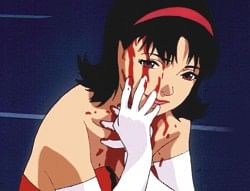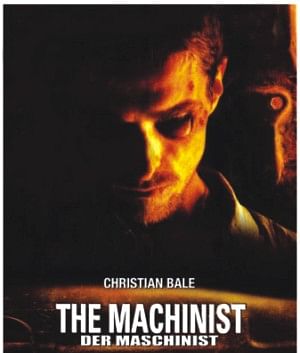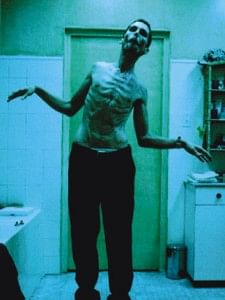
By Ahsan Sajid
 The album cover art for Changing of the Seasons, the third album of singer-songwriter Ane Brun, is simple enough- the unconventionally pretty Norwegian musician in drab shades of gray, standing, staring; with tasteful vignette work (plaudits to the photographer), and what can arguably be called a startling photographic phenomenon- zooming in and out at the same time while using a first curtain slow-synch flash. So what does Ane Brun's blurriness mean, and what does it have to do with the music?
The album cover art for Changing of the Seasons, the third album of singer-songwriter Ane Brun, is simple enough- the unconventionally pretty Norwegian musician in drab shades of gray, standing, staring; with tasteful vignette work (plaudits to the photographer), and what can arguably be called a startling photographic phenomenon- zooming in and out at the same time while using a first curtain slow-synch flash. So what does Ane Brun's blurriness mean, and what does it have to do with the music?
It takes a listen to figure out the personal identity, the searching and exploration, that seeps through this great third album from a fast-emerging singer-songwriter. Spiritual dislocation? Heavy oppression? Solitude? Love lost? I will shy from putting one finger on this album.
Some words on the album can't go without mention; for instance, it's produced by Valgeir Sigurdsson- you will have heard the name if you've listened to Björk, Sigur Rós, Maps, múm or Bonnie Prince Billy. Other collaborative names include Danish composer Malene Bay-Landin and American composer Nico Muhly (who also has past experience with Bonnie Prince Billy) on string arrangements.
An artist perfects her craft with time and while many critics complained about Ane Brun being shy and too reserved before, this album, her third studio album, provides with just the right amount of oomph it takes for a classic. But don't expect music that's friendly to the ears, Ane Brun's looks can be deceptive. There is a sense of melancholia underlying throughout the album, about to break free. It wouldn't be uncommon for a listener to gradually feel at peace with the music, to feel one with it, and move to a downward spiral of depression. Haunting, beautiful and moving in a way that only Ane Brun can accomplish, this is a dark folk masterpiece. One shouldn't take lightly the fact that most folk music hailing from exotic locales tend to be upbeat and cheery. Taking into account Ane Brun's Scandinavian heritage, one can feel the winter's cold and desolation barely contained in her music.
This album is an assortment of spectral melodies that waft in and out of the sonic space between Mazzy Star, Joni Mitchell, Feist and Fiona Apple; but Ms Brun is not for those times you want a good voice to listen to while trying to relax. She is quiet, and she is sad; that's where her power is. Her tremulous, delicate, idiosyncratic voice is at once well suited to these slow, somber folk songs and at the same time startling.Barely rising above a whisper and often accompanied by acoustic guitars and piano, Ane Brun's music is what you'd like to think is familiar, while it proves to be equally haunting.
“It´s the changing of the seasons / He says ”I need them” / I guess I'm too Scandinavian / The relief of spring / Intoxication of summer rain / The clearness of fall / How winter makes me reconsider it all" In the lushness of the season we're enjoying now, this contemplative album uplifts, oppresses, and eventually changes. Despite the criticism Ane Brun has earned for her fearless stand to be who she is and not give in to expectations, to not dress pretty or sing in a delicate voice about things a young lady is expected to sing about, Changing of the Seasons emerges as a tour de force of songwriting, and comes close to being something of an all time classic. The album is meant to be experienced as a whole, but some of the best songs, if you're willing to sample before getting the whole thing, are The Treehouse Song, Ten Seconds and the title track, Changing of the Seasons.
Anime Review


By Le Chupacabra
Drama/Thriller/Mystery
1 Movie
Rex Entertainment
Warning: Ages 18+
Mima Kirigoe, one-third of the small-time band CHAM!, had a relatively cushy life courtesy of their small yet ardent fan base. Seeking a more grandiose existence, her friends and fans are left behind and bid farewell as she enters the realm of acting. Transitioning from relatively unknown singer to a budding television idol proves to be a tough challenge for Mima but she pushes on. However, one of her old fans finds this 'betrayal' more than challenging and begins to stalk her with ill intent.
Life can throw up unexpected surprises when any amount of change takes place - and they're not always pleasant yet we learn to live with them. In Satoshi Kon's disturbing thriller Perfect Blue, an unsuspecting Mima Kirigoe finds that she isn't the only one going through a transformation. One discovers that her journey's comparisons with the works of Hitchcock and Kafka are justified once the viewer begins to lose the thread. Then, it's all a little too uncomfortable and brilliantly so.
We're all aware that people in the limelight tend to have their fair share of those who would do them harm and it isn't surprising when the case, early on, seems to have links to a standard mystery with a murder and a couple of nasty grudges stubbed into the ashtray. It's slow, it's methodical and you can probably take an easy stab at pointing out the transgressor. Of course, that's the way it's built up: just as you think you have control of what you're viewing, something changes. It's a subtle transition but as Mima starts to doubt herself and her decisions, you too find yourself shifting nervously on your seat as your theories and understanding slowly start slipping away. You know there's clearly something wrong but try as you might, it all seems rather intangible. This is where the film succeeds so deliciously, playing with your mind, fiddling with your thoughts.
Its very nature creates a synergy with Mima as you feel as helpless as her, not being able to find the line dividing the real from the surreal. Kudos must be lathered on the scriptwriting for maintaining this unique style and one that doesn't patronise the viewer at that.

The pacing and composition are accomplished adroitly with nary a wasted frame. Repetitious scenes are used to bring a sense of familiarity to the events yet, further in, they create an eerie sense of déjà vu, distorting the viewer's concept of time. Similarly, the meticulous use of narrative perspective keeps any sense of mystery remarkably fresh. This is a master-class in film-making and I dare say that more pedantic viewers will have a grand time trying to look deeper into the heart of matters. The artwork and animation border on realism, with great attention paid to innovative angles and image manipulation to draw the reader into the insanity that creeps up on them. The violence can be rather gratuitous and certain scenes will no doubt elicit shock.
Given that this film deals with a band, it's no surprise that the music is rather catchy if bordering a little too much on techno-pop. Besides the songs, the general sound composition is creative, adding to the atmosphere.
Whatever you do, don't take this film lightly. With its murky subject matter and psychological issues, it's a provocative study into the vagaries of the mind. The themes are distinctly adult, this in addition to the violence, gore and rape that drives home the serious nature of the events that transpire; the film is clearly to be avoided by the young ones. If you want to step back from your brightly-garbed adolescents and their anime friends and give yourself into a little despair, a little madness and a thriller that's deeply unsettling, then get lost in Perfect Blue.

By The Anarchist Kitten
1960's original Psycho style fast scene editing; film score with a heavy, oppressive overuse of bass; gritty, washed-out, grainy photography; the most disturbing parts of the film left unexplained and unexplored; do you want to see what a movie would look like if Hitchcock was alive today, and had at his disposal the best of filmmaking equipment (apart from his very own staple techniques)? We all do, and Brad Anderson's The Machinist is possibly the closest we'll ever come to it.
Looking at Anderson's past we can almost see a pattern forming. Session 9 of 2001, a film about an asbestos cleaning crew working in an abandoned mental hospital with a horrific past that is on the brink of resurfacing, was a gritty psychological thriller that played on the minds of viewers much like Hitchcock's films. Hitchcock's touch of genius in Anderson is apparent, and he does not shy from paying homage to the master, visually if not vocally.
 There is much to praise to be heaped upon The Machinist. From the excellent score (Anderson is a fan of Nine Inch Nails and his taste is reminiscent in the film; the lead character is Trevor Reznik- a tribute to Trent Reznor) to the ambience and atmospheric nature of the film, supported strongly by the actors. Christian Bale takes things to the extreme in his portrayal of the lead character; usually it is silly to hear Hollywood stars losing or gaining weight for a particular role, but Bale's accomplishment is commendable- over a six month diet of only a coffee and an apple a day, our favourite Batman actor Bale lost a staggering sixty-three pounds for the role.
There is much to praise to be heaped upon The Machinist. From the excellent score (Anderson is a fan of Nine Inch Nails and his taste is reminiscent in the film; the lead character is Trevor Reznik- a tribute to Trent Reznor) to the ambience and atmospheric nature of the film, supported strongly by the actors. Christian Bale takes things to the extreme in his portrayal of the lead character; usually it is silly to hear Hollywood stars losing or gaining weight for a particular role, but Bale's accomplishment is commendable- over a six month diet of only a coffee and an apple a day, our favourite Batman actor Bale lost a staggering sixty-three pounds for the role.
After seeing him in films like American Psycho, with the body of a Greek god, it's difficult to viewing Bale in The Machinist weighing only about 120 pounds, playing the role of a industrial worker who hasn't slept in over a year and is slowly losing his sanity. The atmosphere of the film works well with the character, the elements surrounding him looking just as macabre and fey as his mind must be. There are nods to classics, like a well thumbed copy of The Idiot by Dostoevsky that the main character appears to be reading throughout the movie, that he is never shown doing.
It's commonly accepted that subconsciously people decide whether they like a movie or not within the first ten minutes; this accepted formula has lead Hollywood to mass-produce films that manage to glue viewers with its very introduction- in all likelihood a very good thing. But for film aficionados, such a formulaic, structural approach to filmmaking if off-putting, and The Machinist, arguably a box-office flop goes against the grain in introducing new plot elements in almost every scene, without making it overly tedious on the viewer. As the story progresses it gets harder to believe that the denouement will ably explain everything, and one starts realizing that there can only be one possible conclusion connecting all the events; it may be disappointing at first to learn that your predictions are right. But even if you've guessed the twist correctly, the beauty of The Machinist's ending is that there is an explanation to the twist that adds levels to this tried and tested concept. Days after watching, if you go back on the movie and think about it you'll realize the script is much more brilliant than you initially gave it credit for. There is no lose scene in the film, unlike most thrillers; every scene has its purpose.
The Machinist is a definite recommendation for anyone who wants a movie to capture their attention for longer than its run-time. But it's not a recommendation to casual movie-goers; this is an experience for those who appreciate character development and cinematography as much as plot points and a storyline. If you're looking for a typical Hollywood popcorn thriller, then this movie is not for you.
